What Fruits and Vegetables Can Koi Fish Eat? A Guide to Healthy Snacks
This post may contain affiliate links.
Koi fish are a popular choice for outdoor ponds, and their owners often want to provide them with a varied diet.
While commercial pellets form the foundation of their nutrition, supplementing with fruits and vegetables can enhance their health and color vibrancy.
As omnivorous creatures, koi can benefit from a diverse range of foods, but it’s crucial to understand what fruits and vegetables are safe for them to eat.
This guide will explore the world of koi nutrition, helping you make informed decisions about adding fresh produce to their diet.
Key Takeaways
- Understanding koi nutrition is essential for their overall health and well-being.
- Fruits and vegetables can be a healthy addition to a koi’s diet when done correctly.
- Some human foods are toxic to koi, so it’s crucial to know what to avoid.
- A varied diet can enhance the color and vibrancy of your koi.
- Proper preparation of fruits and vegetables is necessary before feeding them to your koi.
Understanding Koi Fish Dietary Needs
Understanding what koi fish eat is essential for their care and well-being. Koi fish, being a domesticated variety of carp, have specific dietary needs that are crucial for their health and vibrant color.
Natural Diet of Koi in the Wild
In their natural habitat, koi fish, which are essentially carp, feed on a variety of food sources including plants, insects, and small crustaceans. Their diet in the wild is diverse and reflects their omnivorous nature.
Nutritional Requirements for Captive Koi
Captive koi require a balanced diet that meets their nutritional needs. Here are some key points to consider:
- Captive koi need a diet containing approximately 30-35% protein, with higher protein needs during growth phases and warmer months.
- Essential nutrients for koi include proteins, carbohydrates, fats, vitamins, and minerals, all contributing to their overall health and color development.
- Different varieties of koi may have slightly different nutritional needs based on their growth rate, scale type, and color pattern development.
- Premium-quality commercial koi food is formulated to meet these nutritional requirements, but supplementing with fresh foods can provide additional benefits.
- The cost of feeding high-quality food to koi can vary significantly, with specialized color-enhancing formulas for expensive koi costing more per fish.
By understanding and meeting the dietary needs of koi, owners can help ensure their fish remain healthy and thrive in their pond environment.
Benefits of Feeding Fruits and Vegetables to Koi Fish
Providing koi fish with a diverse diet that includes fruits and vegetables can enhance their nutritional intake and stimulate natural behaviors. This approach to feeding not only supports the health of the koi but also enriches their environment.
Nutritional Advantages
A diet rich in fruits and vegetables offers koi fish essential nutrients that may be lacking in their regular diet. For instance, fruits like berries are rich in antioxidants, while leafy greens provide vital vitamins and minerals. Incorporating these foods into their diet can lead to improved overall health and vitality.
Behavioral Benefits of Varied Diet
Offering a varied diet encourages natural foraging behaviors among koi, stimulating their intelligence and preventing boredom in pond environments. Hand feeding fresh foods can strengthen the bond between koi and their keepers, making the fish more interactive and responsive. A varied diet also promotes natural behaviors, such as competition for novel food items, which can establish and reinforce social hierarchies among koi.
| Food Type | Nutritional Benefit | Behavioral Impact |
|---|---|---|
| Fruits (e.g., Berries) | Rich in Antioxidants | Encourages Foraging |
| Leafy Greens | Provides Vitamins and Minerals | Promotes Natural Behaviors |

Safe Fruits for Koi Fish
Koi fish can enjoy a range of fruits, but it’s crucial to choose the right ones. Incorporating fruits into their diet can provide essential nutrients and variety. However, not all fruits are safe for koi consumption.
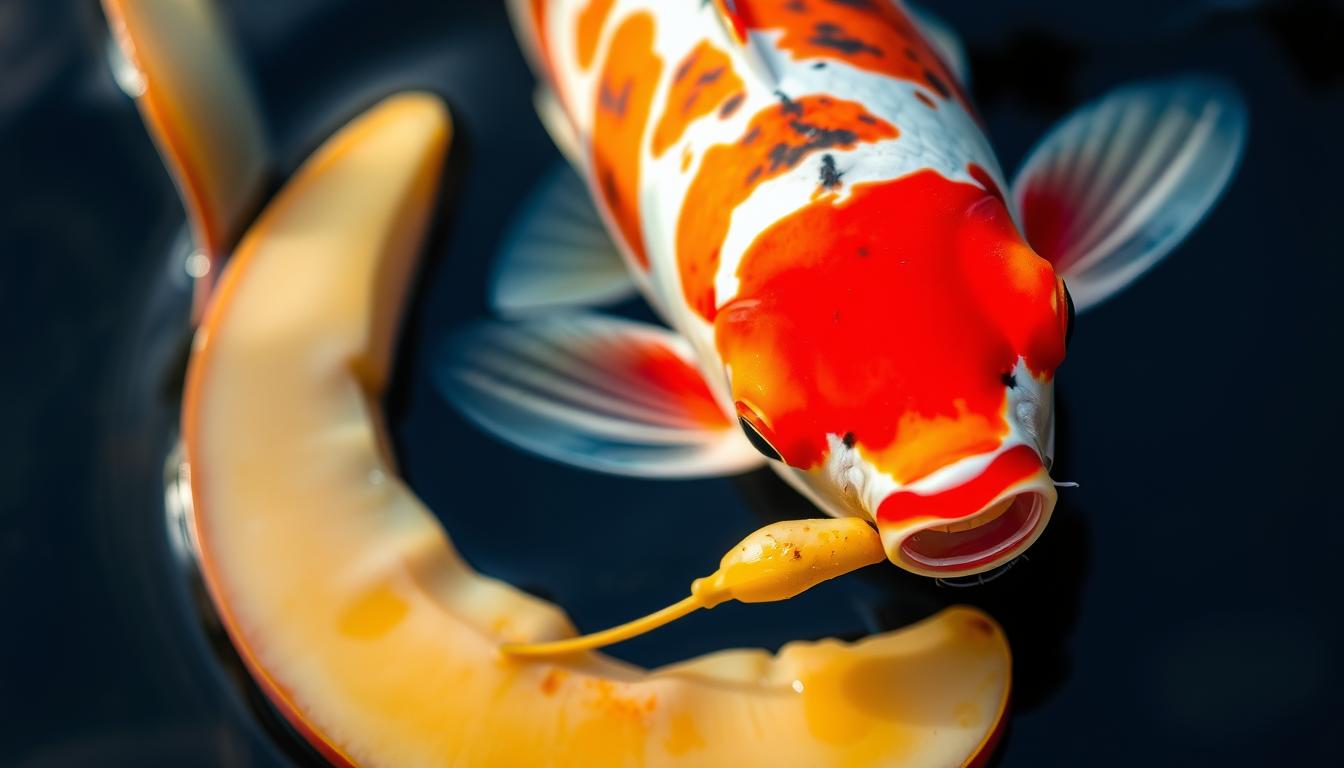
Berries: Strawberries, Blueberries, and Raspberries
Berries are a nutritious and safe option for koi fish. Strawberries, blueberries, and raspberries are rich in antioxidants and can be fed to koi in moderation. These berries provide a sweet treat and are easily digestible.
Melons: Watermelon, Cantaloupe, and Honeydew
Melons are another fruit category that koi fish can enjoy. Watermelon, cantaloupe, and honeydew are refreshing and hydrating. They should be cut into manageable pieces to prevent choking hazards.
Other Fruits: Oranges, Apples, and Grapes
Other fruits like oranges, apples, and grapes can also be fed to koi, but with certain precautions. Citrus fruits like oranges should be given sparingly due to their acidity. Apples are a good source of fiber, benefiting koi of various varieties, including Gin Rin and Shiro Utsuri. Seedless grapes can be offered whole or cut in half, providing a quick energy boost.
- Citrus fruits like oranges should be fed sparingly to koi as the acidity can be difficult for some fish to digest, particularly varieties with specialized digestive needs.
- Apples provide fiber and vitamins that benefit koi of all varieties, from standard types to specialty fish like Gin Rin with their sparkling scales or Shiro Utsuri with their distinctive black and white patterns.
- Seedless grapes can be offered whole to larger koi or cut in half for smaller fish, providing quick energy and natural sugars.
- When feeding fruits with distinct segments like oranges, separate them along natural divisions to create appropriate-sized portions that won’t extend beyond the lateral line of the fish when consumed.
- For all fruits, monitor how different varieties of koi respond, as some may show preferences based on their specific genetic lineage and natural behaviors.
Vegetables That Koi Fish Enjoy
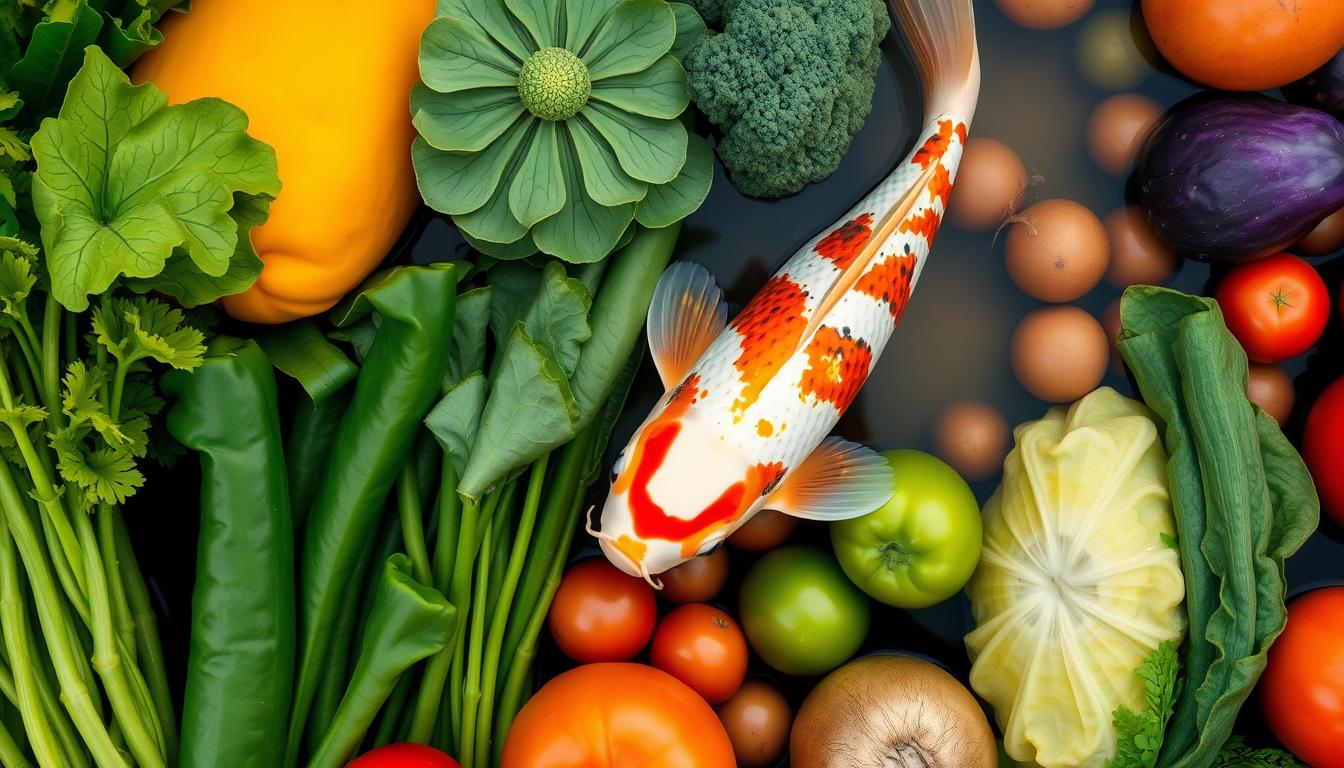
Koi fish have a diverse diet that includes a variety of vegetables, which are essential for their overall health. In their natural habitat, koi fish feed on various aquatic plants, and replicating this diet in a pond setting can be beneficial for their well-being.
Leafy Greens: Lettuce, Spinach, and Kale
Leafy greens are a great addition to a koi fish’s diet. Lettuce, spinach, and kale are rich in nutrients and can be easily consumed by koi fish. These vegetables provide essential vitamins and minerals that support the overall health of the fish.
Root Vegetables: Carrots, Sweet Potatoes, and Beets
Root vegetables like carrots, sweet potatoes, and beets are also suitable for koi fish. They are rich in fiber and nutrients, making them a great treat for the fish. However, it’s essential to cook or blanch them before feeding to make them easier to digest.
Other Vegetables: Peas, Cucumber, and Zucchini
Other vegetables that koi fish enjoy include peas, cucumber, and zucchini. Peas are particularly beneficial for koi digestive health, providing fiber and nutrients while being soft enough for easy consumption. Cucumber has high water content and can be a refreshing treat during warmer months. Zucchini is readily accepted by most koi and can be fed raw in thin slices.
- Peas are particularly beneficial for koi digestive health, providing fiber and nutrients while being soft enough for easy consumption.
- Cucumber has high water content and can be a refreshing treat during warmer months, helping to supplement hydration alongside the pond water.
- Zucchini is readily accepted by most koi and can be fed raw in thin slices that sink to the bottom where bottom-feeding fish can easily access them.
- These vegetables complement the natural diet of koi that would include various aquatic plants in the wild.
- For varieties with distinctive scale patterns like Shiro Utsuri or those with a prominent row of scales along the back, these easily digestible vegetables support overall health without taxing their digestive systems.
Incorporating a variety of vegetables into a koi fish’s diet can provide them with a balanced and nutritious meal. It’s essential to research and understand which vegetables are safe and beneficial for koi fish to ensure their optimal health.
How to Properly Prepare Fruits and Vegetables for Koi
To keep your koi healthy, it’s essential to know how to prepare fruits and vegetables properly for their consumption. Preparing these foods correctly not only ensures they are safe for your koi to eat but also maximizes their nutritional value.
Cleaning and Removing Pesticides
The first step in preparing fruits and vegetables for your koi is to clean them thoroughly. This process involves rinsing the produce under running water to remove dirt, bacteria, and any pesticide residues. Pesticides can be harmful to koi, so it’s crucial to use a vegetable brush to scrub firm produce like apples and carrots. For leafy greens, gently swishing them in a bowl of water can help dislodge dirt and debris. After cleaning, drying the produce can help prevent the spread of bacteria in your pond.
Cutting and Portion Sizes
Once cleaned, cutting the fruits and vegetables into appropriate sizes is vital. Koi have different mouth sizes, and cutting food into manageable pieces ensures they can eat comfortably. A good rule of thumb is to cut produce into pieces that are about the size of their mouth. This not only makes eating easier but also helps prevent choking hazards. For larger koi, you might cut carrots into sticks, while smaller koi might require grated carrots or finely chopped leafy greens.
Blanching and Softening Methods
Some vegetables are too hard for koi to eat raw, so blanching can be a helpful preparation method. Blanching harder vegetables like carrots and sweet potatoes makes them soft enough for koi to eat easily. A quick 1-2 minute blanch in boiling water followed by cooling is sufficient for most vegetables, preserving nutrients while increasing digestibility. For koi with specialized scale types, like Gin Rin or Shiro Utsuri, properly softened food reduces the risk of injury to their distinctive scale patterns during feeding. Freezing and thawing fruits can also naturally soften their texture, making them easier for koi to consume.
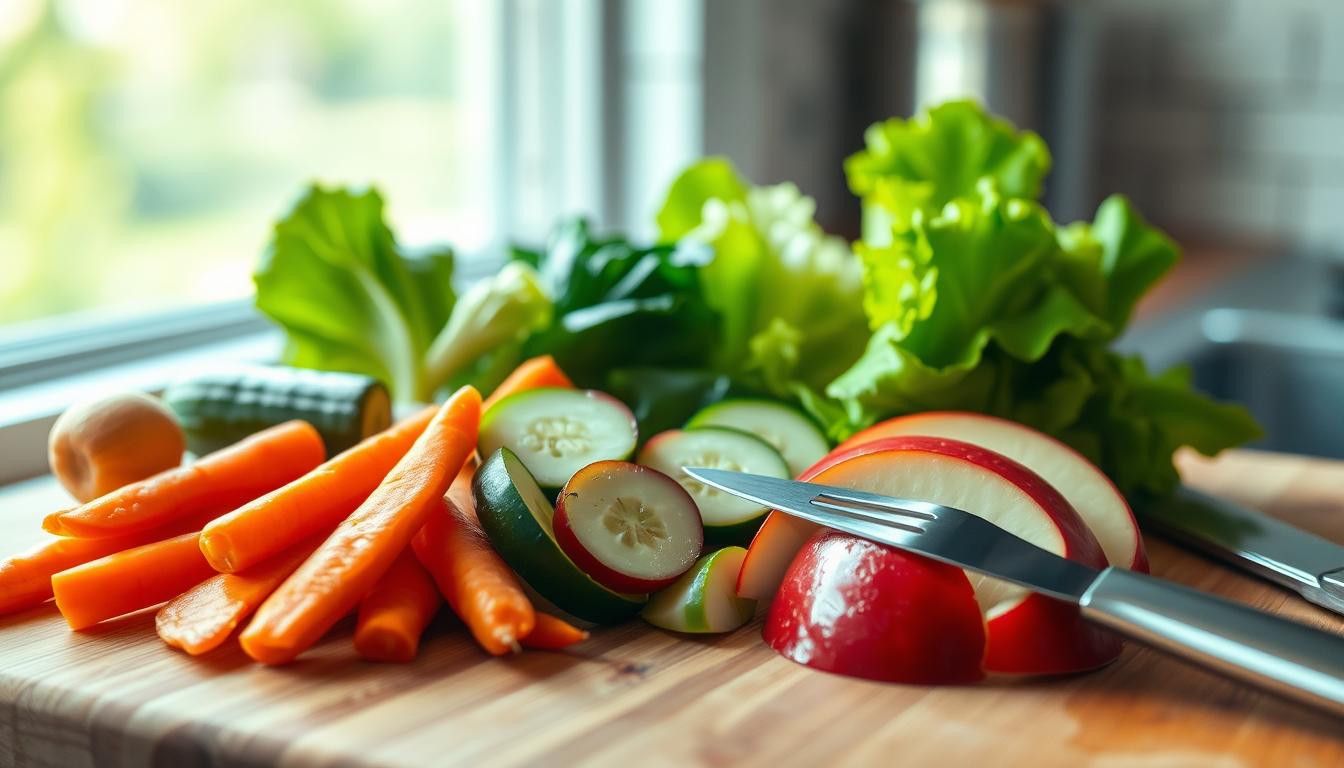
- Blanching vegetables before feeding them to koi can enhance their digestibility and safety.
- Cutting produce into appropriate sizes based on the koi’s mouth size is crucial for safe feeding.
- Cleaning produce thoroughly removes harmful pesticides, ensuring the health of your koi.
By following these preparation steps, you can provide your koi with a varied, nutritious diet that complements their commercial food and supports their overall health and well-being.
Feeding Guidelines for Koi Fish
Establishing a feeding routine is crucial for the health and well-being of your koi fish. A well-planned feeding schedule helps maintain a thriving koi pond and ensures your koi receive the necessary nutrients for optimal growth.
Frequency and Quantity
Feeding your koi fish the right amount at the right frequency is vital. Overfeeding can lead to water quality issues, while underfeeding can result in malnutrition. A general rule of thumb is to feed your koi fish 2-3 times a day, only as much as they can consume within a few minutes.
| Feeding Frequency | Quantity | Benefits |
|---|---|---|
| 2-3 times a day | As much as they can consume within a few minutes | Maintains optimal growth and health |
| Once a day | Limited quantity | Can lead to malnutrition |
Best Times of Day to Feed
The timing of feeding is also crucial. Morning feedings between 8-10 AM are ideal as koi are naturally active during this time and water oxygen levels are typically increasing with rising temperatures.
- Mid-afternoon feedings (2-4 PM) provide energy during peak activity periods when koi are most visible and active in the pond.
- Avoid feeding late in the evening or at night when oxygen levels may naturally decrease in the pond environment.
- Establishing consistent feeding times helps create routine among koi, making it easier to monitor their health and behavior.
- When keeping koi of different varieties together, observe feeding hierarchies to ensure all fish have access to food, adjusting feeding techniques if certain individuals are consistently missing out.
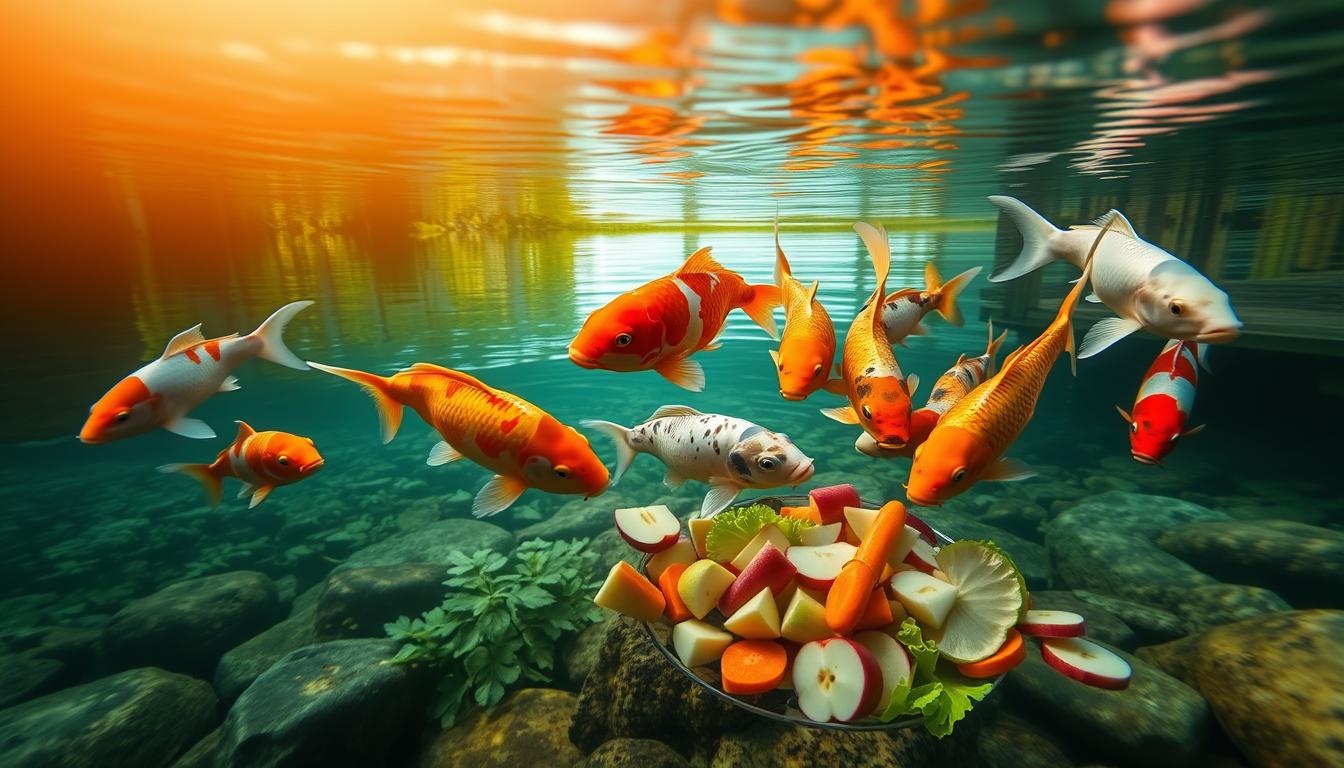
Foods to Avoid Feeding Your Koi Fish
While koi fish can benefit from a varied diet that includes fruits and vegetables, it’s equally important to know what foods to avoid. Certain human foods can be harmful or even toxic to koi, causing a range of health issues from digestive distress to more severe conditions.
Toxic Fruits and Vegetables
Some fruits and vegetables that are safe for human consumption can be detrimental to koi fish. For example, certain plants in the Allium family, such as onions and garlic, contain compounds that can cause anemia and damage to the fish’s red blood cells. It’s also crucial to avoid feeding koi fish unripe, moldy, or spoiled produce, as these can contain toxins harmful to fish.
- Onions and garlic contain compounds toxic to koi.
- Unripe or moldy produce can be harmful.
- Avoid feeding koi fish spoiled or rotten fruits and vegetables.
Other Harmful Human Foods
In addition to toxic fruits and vegetables, there are several other human foods that should be avoided when feeding koi fish. These include:
- Bread and processed grain products, which can cause digestive blockages and fermentation.
- Processed foods with preservatives, artificial colors, or high salt content, which can damage the koi’s osmoregulatory system.
- Dairy products, which are indigestible to koi and can cause severe digestive distress.
- Chocolate and caffeine-containing foods, which contain methylxanthines toxic to fish.
- Nuts and seeds with high fat content, which can lead to fatty liver disease in koi, particularly in ornamental varieties like Utsuri.
By avoiding these harmful foods, you can help ensure the health and well-being of your koi fish. A balanced diet that includes a variety of safe fruits and vegetables, along with high-quality commercial koi food, will keep your koi thriving in their pond.
Seasonal Considerations for Koi Fish Diet
As the seasons change, the dietary needs of your koi fish also shift, requiring adjustments to their feeding schedule and food variety. Koi fish are sensitive to changes in water temperature and quality, which affect their metabolism and nutritional requirements.
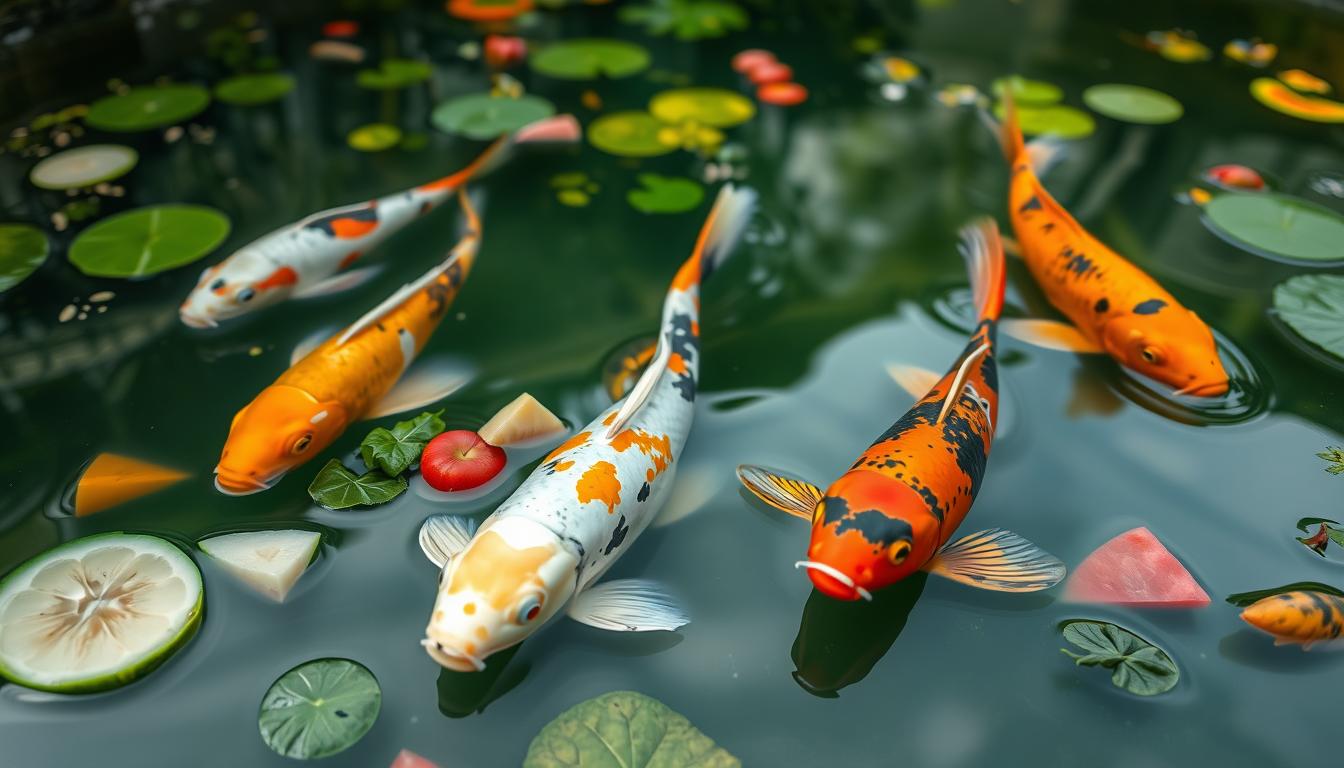
Spring and Summer Feeding
During the spring and summer months, koi fish are more active and require a diet rich in nutrients to support their growth and energy needs. High-quality commercial koi food supplemented with fresh vegetables like peas, lettuce, and watermelon can provide the necessary nutrients. It’s essential to feed them more frequently during this period, as their metabolism is higher due to the warmer water temperatures.
- Offer a varied diet that includes a mix of commercial koi pellets and fresh vegetables.
- Feed your koi fish 2-3 times a day during the spring and summer.
- Ensure that the food is fresh and not left to spoil in the pond.
Fall and Winter Adjustments
As the water temperature drops in the fall, it’s crucial to gradually adjust your koi fish’s diet to more easily digestible foods. Wheatgerm-based foods are an excellent choice during this period, as they are easier to digest. In the winter, when the water temperature falls below 39°F (4°C), koi fish enter a state of semi-dormancy, and their digestive system slows down significantly.
- Gradually reduce the quantity and frequency of feedings as the water temperature drops.
- Switch to wheatgerm-based foods supplemented with soft vegetables like peas.
- Limit feeding to only the warmest part of the day during the winter, if at all.
By adjusting your koi fish’s diet according to the seasonal changes, you can ensure their optimal health and well-being throughout the year.
Balancing Commercial Food with Fresh Produce
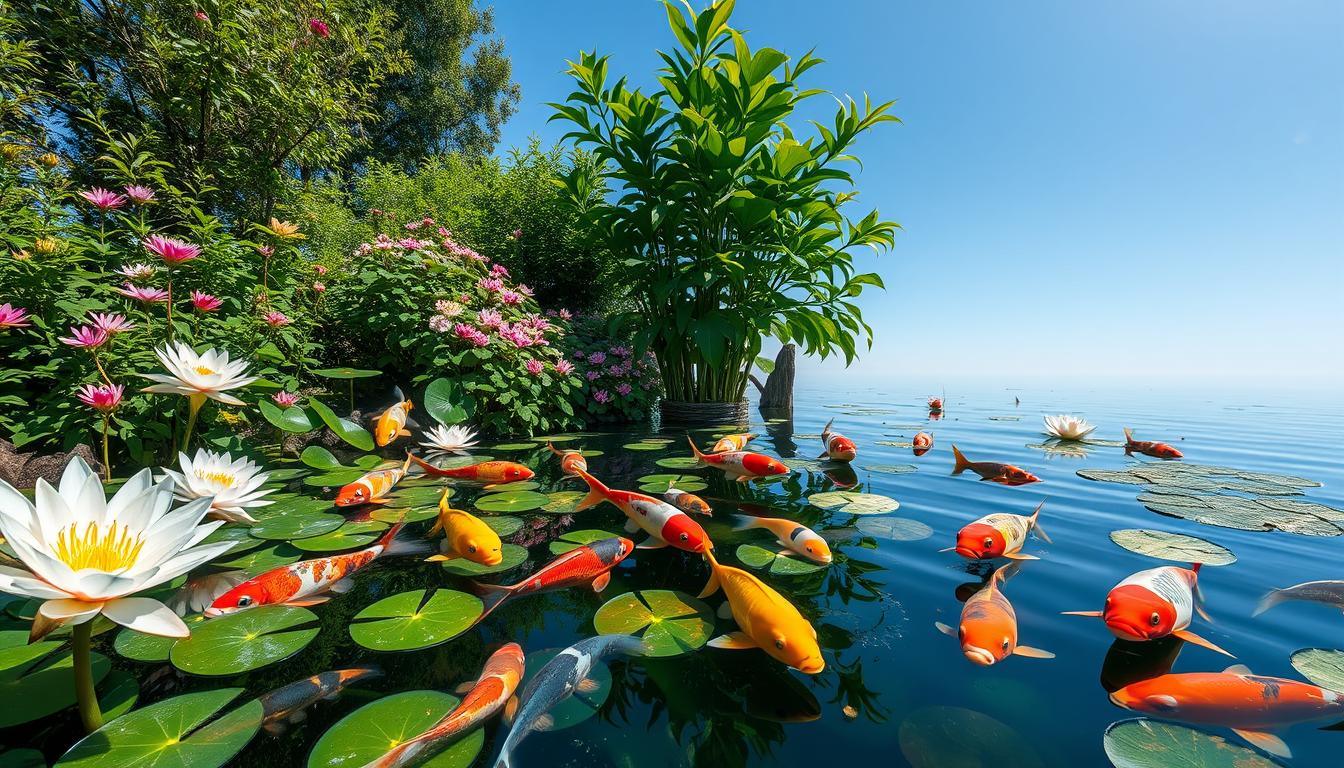
To keep your koi thriving, it’s vital to strike the right balance between commercial and fresh foods. A well-balanced diet is crucial for maintaining their health, vibrant colors, and overall longevity.
Types of Commercial Koi Food
Commercial koi food is available in various forms, including pellets, flakes, and sticks. These products are formulated to provide a nutritionally balanced diet for your koi. When selecting a commercial food, look for high-quality products that are rich in nutrients and suitable for your koi’s life stage.
Pellets are a popular choice as they are easy to measure and provide a consistent diet. Flakes can be used as a supplement or for smaller koi, while sticks are often used for floating foods that can help reduce waste.
Creating a Balanced Diet Plan
A well-balanced koi diet typically consists of 80-90% high-quality commercial food with 10-20% fresh produce supplements. Rotate different fruits and vegetables throughout the week to provide varied nutrients and prevent potential vitamin imbalances.
- A well-balanced koi diet typically consists of 80-90% high-quality commercial food with 10-20% fresh produce supplements.
- Rotate different fruits and vegetables throughout the week to provide varied nutrients and prevent potential vitamin imbalances.
- Introduce new foods gradually, observing how your koi respond and adjusting portions accordingly.
- For specialized varieties with specific color development needs, customize the fresh food portion to support those traits (e.g., more carotenoid-rich foods for red and yellow varieties).
- Keep a feeding journal to track which foods your koi prefer and how different items affect their color, activity level, and overall body condition over time.
By following these guidelines and maintaining a balanced diet, you can ensure your koi remain healthy and vibrant. Regularly monitoring their response to different foods and making adjustments as needed is key to their overall well-being.
Health Benefits of Different Fruits and Vegetables for Koi
Incorporating fruits and vegetables into a koi fish’s diet can lead to numerous health benefits, including enhanced color and immune function. A varied diet supports the overall well-being of these beautiful koi, ensuring they thrive in their pond environment.
Color Enhancement Properties
Certain fruits and vegetables can enhance the vibrant colors of koi. For instance, feeding them carrots can intensify their orange hues, while leafy greens like spinach can deepen their green tones. The quality of the water and the overall health of the fish also play a significant role in maintaining their color.
| Fruit/Vegetable | Color Enhancement |
|---|---|
| Carrots | Intensifies orange hues |
| Spinach | Deepens green tones |
| Tomatoes | Enhances red colors |
Immune System Support
A diet rich in fruits and vegetables can also support the immune system of koi. Citrus fruits, for example, provide vitamin C, which is essential for immune function. Berries contain polyphenols that may help reduce inflammation and support overall immune health in all varieties of koi, including those with distinctive patterns like Shiro Utsuri.
- Garlic supplements contain allicin, which has natural antibacterial and antiparasitic properties beneficial for koi.
- Citrus fruits provide vitamin C, supporting immune function and stress resistance.
- Dark leafy greens supply antioxidants that help combat cellular damage from environmental stressors.
By incorporating a variety of fruits and vegetables into their diet, koi owners can help ensure their fish remain healthy and vibrant, with a strong immune system to fight off diseases.
Introducing New Foods to Your Koi Fish
To keep your koi healthy and thriving, introducing new foods should be a gradual process. This approach helps prevent digestive issues and allows your koi to adjust to new flavors and textures.
Gradual Introduction Methods
When introducing new foods, start by mixing a small amount with their current diet. Begin with a ratio of 10% new food to 90% regular food and gradually increase the proportion over 7-10 days. This method allows your koi to become accustomed to the new food without feeling overwhelmed.
It’s also beneficial to vary the types of new foods introduced. For instance, if you’re adding a new fruit, try alternating between different fruits like watermelon one day and strawberries the next. This variety helps ensure a broad spectrum of nutrients.
Monitoring for Adverse Reactions
As you introduce new foods, it’s crucial to observe your koi closely for any signs of digestive distress. Monitor water quality parameters more frequently, as uneaten portions can quickly degrade water conditions. Watch for changes in fecal matter, as abnormal waste can indicate digestive issues.
- Observe your koi for unusual swimming patterns or floating, which can be signs of digestive upset.
- Be alert for physical reactions such as flashing or clamped fins, which might indicate an adverse reaction to the new food.
- When keeping koi in outdoor ponds, promptly remove uneaten new foods to prevent algae blooms.
Troubleshooting Common Feeding Issues
Maintaining a healthy diet for koi fish is crucial, and troubleshooting common feeding issues is an essential part of koi care. Koi fish owners often face challenges in ensuring their pets are fed properly without compromising water quality or the fish’s health.
Addressing Picky Eaters
Some koi fish can be picky eaters, refusing certain foods. To address this, it’s essential to offer a variety of foods, including fruits and vegetables. This not only ensures they receive a balanced diet but also keeps them interested in their food. For instance, offering leafy greens like lettuce or spinach can be a nutritious and appealing option.
Managing Uneaten Food in the Pond
Uneaten food can quickly become a water quality issue, breaking down and releasing ammonia that can stress or harm koi fish. To manage this, use a fine net to remove any visible uneaten food items 15-20 minutes after feeding. Consider using feeding rings that contain floating foods in one area, making it easier to monitor consumption and remove leftovers.
| Feeding Practice | Benefits |
|---|---|
| Using feeding rings | Keeps food contained, making it easier to remove uneaten food |
| Monitoring consumption | Helps adjust portion sizes to prevent overfeeding |
| Removing uneaten food | Prevents water quality issues by reducing ammonia release |
Adjusting portion sizes downward if you consistently find uneaten food is crucial, as overfeeding is one of the most common mistakes made by koi keepers. Professional koi breeders often recommend feeding only what your fish can consume in 5 minutes to prevent waste accumulation in the pond environment.
Conclusion
A varied diet that includes fresh produce is vital for the well-being of koi fish. By incorporating a range of fruits and vegetables into their diet, you can enhance their health, coloration, and overall vibrancy.
Remember, koi are descendants of wild carp, and their natural diet includes plant matter. Replicating this through carefully selected produce can help maintain their natural patterns and colors.
Different varieties of koi may show preferences for certain foods, so it’s worthwhile to experiment with various options to find what works best for your specific fish. Maintaining proper feeding practices contributes significantly to water quality and disease prevention.
By understanding what to feed and what to avoid, koi keepers can provide their fish with a diet that supports optimal health while minimizing potential risks. This thoughtful approach to nutrition can enhance the good fortune associated with these ornamental carp in Japanese koi culture.
The relationship between koi and their keepers is often strengthened through the feeding process, creating a rewarding experience that contributes to the enjoyment of these living jewels in the pond.
